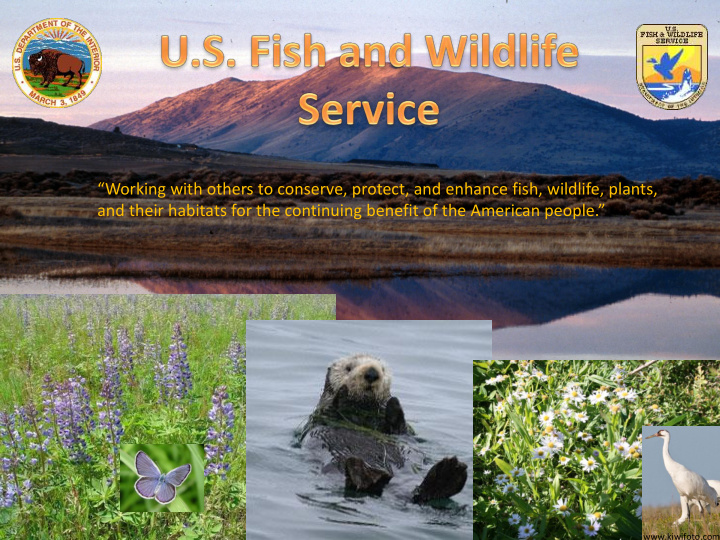



“Working with others to conserve, protect, and enhance fish, wildlife, plants, and their habitats for the continuing benefit of the American people.” www.kiwifoto.com
Ecological Services National Wildlife Refuge System Migratory Bird Program Fisheries Program Law Enforcement
USGS National Wind Turbine Dataset
Ecological Services Field Office • Endangered Species Act • Protection • Recovery • Fish and Wildlife Coordination Act • Natural Resources Protection • Partners for Fish and Wildlife Program • Projects with Landowners • Contaminants • Assessment, Litigation
Renewable Energy Coordinator • Work with Wind Developers and Facility Operators to avoid and minimize impacts to protected species • Follow the framework of the FWS Land Based Wind Energy Guidelines (published in 2012) • A 5-tiered approach to siting and operating with a wildlife impact perspective • Developer-led process, voluntary, but strongly encouraged • Documents coordination with FWS in case of a law violation (e.g. killing migratory birds, Eagles, or species protected by the Endangered Species Act) • Usually ends in a Bird and Bat Conservation Strategy, + a “Technical Assistance Letter” or take permit. • I use this framework to guide wind developers to compliance with the Migratory Bird Treaty Act, Endangered Species Act, & Bald and Golden Eagle Protection Act
• Tier 1: Preliminary Site Evaluation (Desktop) • Tier 2: Site Characterization (Desktop and Field) • Tier 3: Field Studies to Document Wildlife/Habitat & Predict Impacts • Tier 4: Post-Construction Studies to Estimate Impacts • Tier 5: Other Post-Construction Studies
TIER 1: Preliminary Site Evaluation
TIER 1: Preliminary Site Evaluation
TIER 2: Preliminary Site Evaluation Closest Known Bat Hibernacula Known Bald Eagle Nests, USFWS 2014 (Indiana bats and Northern long- (Note any within 10 miles) eared bats surveys?) FWS also advises that E-IL is a major stopover site for the American Golden Plover
TIER 3: Field Studies and Impact Prediction FIELD STUDIES • Avian Point Counts and Nest Searches • Hired bird observer, scans multiple points in project area for set time (~20 min) periodically throughout the year • Searches for raptor & eagle stick-nests – driving or plane/helicopter surveys in spring, before leaf-out • Acoustic Bat Surveys • Ultrasonic Bat Call Detectors • Mounted on Met Towers • In surrounding habitat • Mist-Net Bat Surveys • In forested river and stream corridors or blocks of mature forested habitat
TIER 3: Field Studies and Impact Prediction Example Study Results • <90 species of birds • Handful of plovers • Average of less than 1 bird per point count session • Red-winged black birds, starlings, cowbirds, larks, only 1 or two hawks, no eagles • NLEB’s captured in riparian areas, but no I -bats • <3 bat passes per detector night – ground, <1 bp/dn raised, >15 bp/dn in adjacent forest
TIER 3: Field Studies and Impact Prediction Assess Impacts from Field Studies • Low bird use + no raptor or eagle presence = no fatal flaws! • Bat use (acoustics) was very low = not a fatal flaw! • Presence of NLEB’s in riparian areas = CAUTION! • FWS says migratory (fall) risk to I- bat and NLEB’s = CAUTION! Avoidance/Minimization Measures – Siting and Operation • Presence of NLEB’s in riparian areas = Avoid killing this species in the summer by setting all turbines back at least 1000’ from any forested area. • FWS says migratory (fall) risk to I- bat and NLEB’s = (Feather all turbine blades below a threshold wind-speed (currently 6.9 m/s is recommended).
TIER 2: Preliminary Site Evaluation TIER 3: Field Studies and Impact Prediction KEY STEP! Document Findings and Submit to USFWS • Bird and Bat Conservation Strategy • Describes studies and results • Documents anticipated risk • Commits to conservation measures • Describes post-construction monitoring plan • Adaptive management strategy for unforeseen event (e.g. eagle or listed bat take) • Service Issues TAL
TIER 4: Post-Construction Studies Mortality Monitoring • Purpose: document turbine-related mortality of birds and bats. • Timing: Spring and Fall, or Year-Round • First 3 years • All or a subset of the turbines. • Roads and pad and full-plots (60 m – 100 m radius) • Results corrected for searcher efficiency, carcass removal rates, and proportion of wind facility searched. • Share results with the Service & adjust consv. measures, if necessary.
Wildlife Impacts – Why are siting and conservation measures so important? • Turbines do strike bats • Range of bat fatalities in Midwest 2 bats/turbine/year to 30 bats/turbine/year. • Rough avg in IL: about 14 bats/turbine. • Potential for about 30,000 dead bats per year in IL alone. (Most common species killed are Hoary, Silver- haired, and Eastern red bat.) • Raising cut-in speeds to 5.0 m/s may reduce mortality by 50-75%! Reducing to 6.9 m/s may reduce mortality by > 90%! • Turbines can strike eagles • Approximately 6 fatality events in Iowa to-date
TIER 5: Other Research Cool Extras! • Exploring the relationship of cut-in speeds to bird and bat mortality rates. • Exploring effect of acoustic deterrents on bat mortality • Migration studies to map migration paths of known Indiana and NLEB bat colonies. • Exploring the temporal patterns of mortality. • Tracking eagle movements across the landscape in relationship to wind-farm locations • Pre- and post-construction American golden plover use (looking for displacement).
Discussion – Questions?
Recommend
More recommend